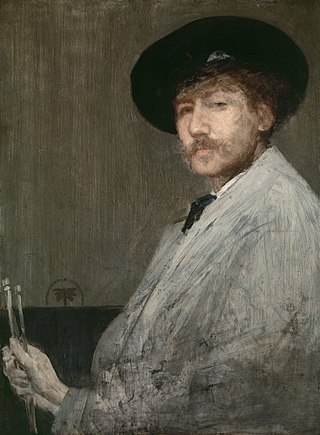
James Abbott McNeill Whistler was an American painter in oils and watercolor, and printmaker, active during the American Gilded Age and based primarily in the United Kingdom. He eschewed sentimentality and moral allusion in painting and was a leading proponent of the credo "art for art's sake".

The Salon des Refusés, French for "exhibition of rejects", is generally known as an exhibition of works rejected by the jury of the official Paris Salon, but the term is most famously used to refer to the Salon des Refusés of 1863.
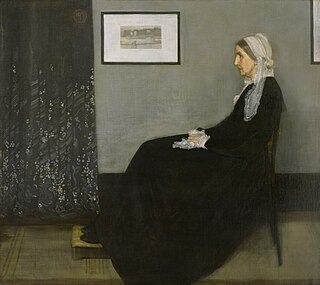
Arrangement in Grey and Black No. 1, best known under its colloquial name Whistler's Mother or Portrait of Artist's Mother, is a painting in oils on canvas created by the American-born painter James McNeill Whistler in 1871. The subject of the painting is Whistler's mother, Anna McNeill Whistler. The painting is 56.81 by 63.94 inches, displayed in a frame of Whistler's own design. It is held by the Musée d'Orsay in Paris, having been bought by the French state in 1891. It is one of the most famous works by an American artist outside the United States. It has been variously described as an American icon and a Victorian Mona Lisa.

The Gentle Art of Making Enemies is a book by the painter James McNeill Whistler, published in London in 1890 by William Heinemann, who also published a second, enlarged edition in 1892. The book was in part a response to, in part a transcript of, Whistler's famous libel suit against critic John Ruskin. Ruskin, in a review of the inaugural showing at the Grosvenor Gallery, had referred to Whistler's painting Nocturne in Black and Gold – The Falling Rocket as "flinging a pot of paint in the public's face". The book contains Whistler's letters to newspapers chronicling his many petty grievances against various acquaintances and friends, and it contains his famous 1885 lecture, "Ten O'Clock", explaining "the meaning and purpose of art".
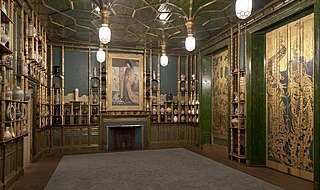
Harmony in Blue and Gold: The Peacock Room is a masterpiece of interior decorative art created by James McNeill Whistler and Thomas Jeckyll, translocated to the Freer Gallery of Art in Washington, DC. Whistler painted the paneled room in a rich and unified palette of brilliant blue-greens with over-glazing and metallic gold leaf. Painted between 1876–77, it now is considered one of the greatest surviving Aesthetic interiors, and best examples of the Anglo-Japanese style.

Maud Franklin was an English artist and the mistress of and model for artist James McNeill Whistler.

Joanna Hiffernan or Joanna Heffernan was an Irish artists' model and muse who was romantically linked with American painter James Abbott McNeill Whistler and French painter Gustave Courbet. In addition to being an artists' model, Hiffernan herself also drew and painted, although it is not believed she ever exhibited her work.

In art, a 'nocturne' its broader sense distinguishes paintings of a night scene, or night-piece, such as Rembrandt's The Night Watch, or the German Romantic Caspar David Friedrich's Two Men Contemplating the Moon of 1819.
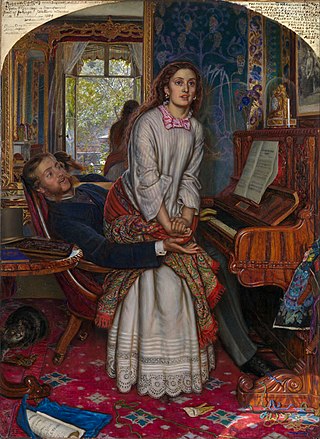
The Awakening Conscience (1853) is an oil-on-canvas painting by the English artist William Holman Hunt, one of the founders of the Pre-Raphaelite Brotherhood, which depicts a woman rising from her position in a man's lap and gazing transfixed out room's window.
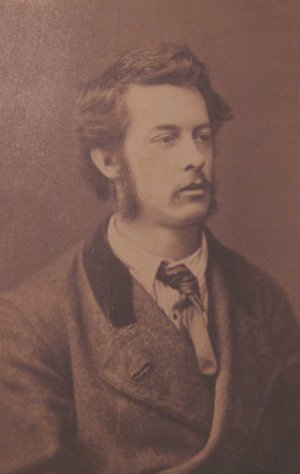
William Edward Frank Britten was a British painter and illustrator. It is known that he worked in London, England starting in 1873 and that he stayed in the city until at least 1890. Britten's work ranged in style from to traditional Victorian to Pre-Raphaelite, and his artistic medium ranged from paintings to book illustrations. His paintings have mostly been praised by critics with his illustrations having been treated as either neutral or favourable by reviewers.

Charles Augustus Howell was an art dealer and alleged blackmailer who is best known for persuading the poet Dante Gabriel Rossetti to dig up the poems he buried with his wife Elizabeth Siddal. His reputation as a blackmailer inspired Arthur Conan Doyle's Sherlock Holmes story "The Adventure of Charles Augustus Milverton".

Symphony in White, No. 1, also known as The White Girl, is a painting by James McNeill Whistler. The work shows a woman in full figure standing on a dog skin in front of a beige curtain with a lily in her hand. The colour scheme of the painting is almost entirely white. The model is Joanna Hiffernan, the artist's mistress. Though the painting was originally called The White Girl, Whistler later started calling it Symphony in White, No. 1. By referring to his work in such abstract terms, he intended to emphasize his "art for art's sake" philosophy.

Symphony in White, No. 3, is a painting by James McNeill Whistler. The work shows two women, one sitting on a sofa dressed in white, and the other resting on the floor, with a yellowish dress. The model on the sofa is Joanna Heffernan, the artist's mistress. By calling the painting Symphony in White, No. 3, Whistler intended to emphasise his artistic philosophy of corresponding arts, inspired by the poet Charles Baudelaire. The presence of a fan on the floor shows the influence of Japonisme, which was a popular artistic trend in European art at the time. Whistler was also greatly influenced by his colleague and friend Albert Joseph Moore, and their works show considerable similarities.

Rose and Silver: The Princess from the Land of Porcelain is a painting by American-born artist James McNeill Whistler. It was painted between 1863 and 1865. The painting currently hangs above the fireplace in The Peacock Room at the Freer Gallery of Art in Washington, D.C.

Mother of Pearl and Silver: The Andalusian is a painting by James McNeill Whistler. The work shows a woman in full figure standing with her back to the viewer, with her head in profile. The model is Ethel Whibley, the artist's secretary and sister-in-law.

Lady in White is an impressionist painting of a woman wearing a white robe, from 1886, by Dutch painter Jan Toorop.

Beatrice Whistler was born in Chelsea, London on 12 May 1857. She was the eldest daughter of ten children of the sculptor John Birnie Philip and Frances Black. She studied art in her father's studio and with Edward William Godwin who was an architect-designer. On 4 January 1876 she became the second wife of Edward Godwin. Following the death of Godwin, Beatrice married James McNeill Whistler on 11 August 1888.
Rosalind Birnie Philip was the sister-in-law of James McNeill Whistler. After the death of her sister Beatrice in 1896 Rosalind acted as secretary to Whistler and was appointed Whistler's sole beneficiary and the executrix in his will.
John Gerald Potter (1829–1908) was an English wallpaper manufacturer, known also as a patron of James McNeill Whistler.

Académie Carmen, also known as Whistler's School, was a short-lived Parisian art school founded by James McNeill Whistler. It operated from 1898 to 1901.


















